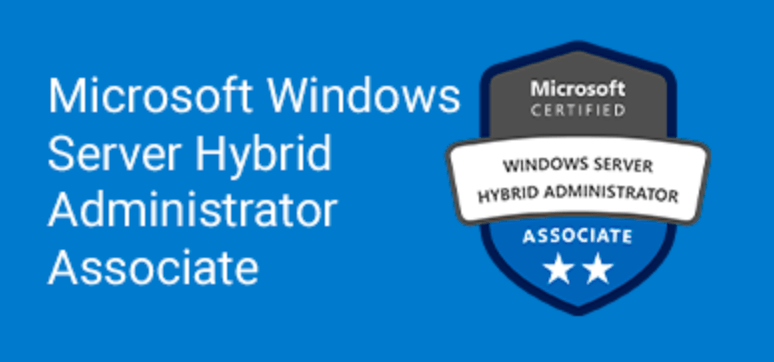
Lab: Configuring security in Windows Server
Scenario
Contoso Pharmaceuticals is a medical research company with about 5,000 employees worldwide. They have specific needs for ensuring that medical records and data remain private. The company has a headquarters location and multiple worldwide sites. Contoso has recently deployed a Windows Server and Windows client infrastructure. You have been asked to implement improvements in the server security configuration.
Note: An interactive lab simulation is available that allows you to click through this lab at your own pace. You may find slight differences between the interactive simulation and the hosted lab, but the core concepts and ideas being demonstrated are the same.
Objectives
After completing this lab, you will be able to:
- Configure Windows Defender Credential Guard.
- Locate problematic user accounts.
- Implement and verify LAPS (Local Administrator Password Solution).
Estimated time: 40 minutes
Lab setup
Virtual machines: AZ-801T00A-SEA-DC1, AZ-801T00A-SEA-SVR1, and AZ-801T00A-SEA-SVR2 must be running. Other VMs can be running, but they aren’t required for this lab.
Note: AZ-801T00A-SEA-DC1, AZ-801T00A-SEA-SVR1, and AZ-801T00A-SEA-SVR2 virtual machines are hosting the installation of SEA-DC1, SEA-SVR1, and SEA-SVR2.
- Select SEA-SVR2.
- Sign in using the following credentials:
- Username: Administrator
- Password: Pa55w.rd
- Domain: CONTOSO
For this lab, you’ll use the available VM environment.
Exercise 1: Configuring Windows Defender Credential Guard
Scenario
You decided to implement Windows Defender Credential Guard on the servers and administrative workstations to protect against Pass-the-Hash and Pass-the-Ticket credential thefts. You will use Group Policy to enable Credential Guard on your existing servers. For all new servers, you will use the Hypervisor-Protected Code Integrity (HVCI) and Windows Defender Credential Guard hardware readiness tool to enable Credential Guard before the new servers are domain-joined.
In this lab, you will set up the Group Policy and run the HVCI and Windows Defender Credential Guard hardware readiness tool on an existing server.
Note: In the lab environment, Credential Guard will not be available on VMs because they don’t meet the prerequisites. This, however, will not prevent you from stepping through the process of implementing it by using Group Policy and evaluating its readiness by using corresponding tools.
The main tasks for this exercise are to:
- Enable Windows Defender Credential Guard using Group Policy.
- Enable Windows Defender Credential Guard using the HVCI and Windows Defender Credential Guard hardware readiness tool.
Task 1: Enable Windows Defender Credential Guard using Group Policy
- On SEA-SVR2, open the Group Policy Management console.
- In the Group Policy Management console, browse through Forest: contoso.com, Domains, contoso.com, and then create a Group Policy Object (GPO) named CredentialGuard_GPO linked to the IT organizational unit (OU).
- Open CredentialGuard_GPO in the Group Policy Management Editor and browse to the Computer Configuration\Policies\Administrative Templates\System\Device Guard node.
- Enable the Turn On Virtualization Based Security option with the following settings:
- Select Platform Security Level: Secure Boot and DMA Protection.
- Credential Guard Configuration: Enabled with UEFI lock.
- Secure Launch Configuration: Enabled
- Close the Group Policy Management Editor window.
- Close the Group Policy Management console window.
Task 2: Enable Windows Defender Credential Guard using the HVCI and Windows Defender Credential Guard hardware readiness tool
- On SEA-SVR2, start Windows PowerShell as administrator.
- To run the HVCI and Windows Defender Credential Guard hardware readiness tool, at the Windows PowerShell command prompt, run the following commands:Code
Set-Location -Path C:\Labfiles\Lab01\ .\DG_Readiness_Tool.ps1 -Enable -AutoReboot - Wait until the tool completes its run and follow the prompts to restart the operating system.
- Once the restart completes, sign back into SEA-SVR2 as CONTOSO\Administrator, with the password Pa55w.rd.
Results
After completing this exercise, you will have:
- Used Group Policy to implement Windows Defender Credential Guard on all computers in your organization.
- Enabled Windows Defender Credential guard immediately on your local computer.
Exercise 2: Locating problematic accounts
Scenario
You want to check whether your organization has user accounts with passwords that are configured not to expire and remediate this setting. You also want to check which accounts haven’t signed in for 90 days or more and disable them.
The main tasks for this exercise are to:
- Locate and reconfigure domain accounts with non-expiring passwords.
- Locate and disable domain accounts that have not been used to sign in for at least 90 days.
Task 1: Locate and reconfigure domain accounts with non-expiring passwords
- On SEA-SVR2, start Windows Powershell as administrator.
- To list Active Directory-enabled user accounts with a non-expiring password, at the Windows PowerShell command prompt, run the following command:Code
Get-ADUser -Filter {Enabled -eq $true -and PasswordNeverExpires -eq $true} - Review the list of user accounts returned.
- To enable password expiration for all user accounts in the result set, at the Windows PowerShell command prompt, run the following command:Code
Get-ADUser -Filter {Enabled -eq $true -and PasswordNeverExpires -eq $true} | Set-ADUser -PasswordNeverExpires $false - To verify the outcome, rerun the command from step 2 and notice that no results are returned.
Task 2: Locate and disable domain accounts that have not been used to sign in for at least 90 days
- To identify Active Directory user accounts that have not been used to sign in for at least 90 days, at the Windows PowerShell command prompt, run the following command:Code
$days = (Get-Date).AddDays(-90) Get-ADUser -Filter {LastLogonTimeStamp -lt $days -and enabled -eq $true} -Properties LastLogonTimeStampNote: In the lab environment, no results will be returned.
- To disable Active Directory user accounts that have not been used to sign in for at least 90 days, run the following command:Code
Get-ADUser -Filter {LastLogonTimeStamp -lt $days -and enabled -eq $true} -Properties LastLogonTimeStamp | Disable-ADAccountNote: In the lab environment, no results will be returned.
Exercise 3: Implementing LAPS
Scenario
At present, the same local administrator account password is used across all servers and workstations at Contoso. To remedy this problem, you will configure and deploy LAPs.
The main tasks for this exercise are to:
- Prepare computer accounts for implementing LAPS (Local Administrator Password Solution).
- Prepare Active Directory (AD DS) for LAPS.
- Deploy LAPS client-side extension.
- Verify LAPS.
Task 1: Prepare computer accounts for implementing LAPS (Local Administrator Password Solution)
- To create a designated OU and move the SEA-SVR1 computer account to it, on SEA-SVR2, at the Windows PowerShell command prompt, run the following command:Code
New-ADOrganizationalUnit -Name "Seattle_Servers" Get-ADComputer SEA-SVR1 | Move-ADObject –TargetPath "OU=Seattle_Servers,DC=Contoso,DC=com" - To install LAPS, at the Windows PowerShell command prompt, run the following command:Code
Msiexec /i C:\Labfiles\Lab01\LAPS.x64.msi - When prompted, step through the Welcome to the Local Administrator Password Solution Setup Wizard with the default settings until you reach the Custom Setup page.
- On the Custom Setup page of the Local Administrator Password Solution Setup wizard, in the drop-down menu next to Management Tools, select Entire feature will be installed on the local hard drive, and complete the wizard by accepting the default settings and launching the setup.
- Wait until the setup completes.
- To enable the Windows Defender Firewall with Advanced Security rule that allows incoming Server Message Block (SMB) connections from other domain-joined servers, at the Windows PowerShell command prompt, enter the following commands, and after each, press Enter:Code
$rule = Get-NetFirewallRule | Where-Object DisplayName -eq 'File and Printer Sharing (SMB-In)' $rule | Set-NetFirewallRule -Profile Domain $rule | Enable-NetFirewallRuleNote: This is required to connect to SEA-SVR2 from SEA-SVR1 later in this lab.
Task 2: Prepare AD DS for LAPS
- To prepare the domain for LAPS, on SEA-SVR2, at the Windows PowerShell command prompt, run the following commands:Code
Import-Module admpwd.ps Update-AdmPwdADSchema Set-AdmPwdComputerSelfPermission -Identity "Seattle_Servers" - On *SEA-SVR2** open Group Policy Management console.
- In the Group Policy Management console, browse through Forest: contoso.com, Domains, contoso.com, and then create a Group Policy Object (GPO) named LAPS_GPO linked to the Seattle_Servers OU.
- Open LAPS_GPO in the Group Policy Management Editor and browse to the Computer Configuration\Policies\Administrative Templates\LAPS node.
- Enable the Enable local admin password management option.
- Configure the Password Settings option with the following settings:
- Select Platform Security Level: Secure Boot and DMA Protection.
- Credential Guard Configuration: Enabled with UEFI lock.
- Secure Launch Configuration: Enabled
- Close the Group Policy Management Editor window.
- Password Length: 20
- Password Age (Days): 30
- Close the Group Policy Management Editor.
- Close the Group Policy Management console window.
Task 3: Deploy LAPS client-side extension
- Switch to the console session to SEA-SVR1 and then, if needed, sign in as CONTOSO\Administrator with the password Pa55w.rd.
Note: You will be prompted to change your password, as a result of running in the previous exercise the script that enables password expiration. Choose an arbitrary password and use it throughout the remainder of the lab.
- Once you sign in, to access the Windows PowerShell command prompt, exit the SConfig menu.
- To install LAPS silently with the default settings, at the Windows PowerShell command prompt, run the following command:Code
Start-Process msiexec.exe -Wait -ArgumentList '/i \\SEA-SVR2.contoso.com\c$\Labfiles\Lab01\LAPS.x64.msi /quiet' - To trigger the processing of Group Policy that will apply LAPS settings locally, at the Windows PowerShell command prompt, run the following command:Code
gpupdate /force
Task 4: Verify LAPS
- Switch to the console session to SEA-SVR2.
- From the Start menu, launch LAPS UI.
- In the LAPS UI dialog box, in the ComputerName text box, enter SEA-SVR1, and then select Search.
- Review the Password and the Password expires values, and then select Exit.
- Switch to the Windows PowerShell console and then, to verify the value of the password, at the Windows PowerShell command prompt, run the following command:Code
Get-ADComputer -Identity SEA-SVR1 -Properties ms-Mcs-AdmPwd - Review the password assigned to SEA-SVR1 and note that it matches the one displayed in the LAPS UI tool.
Note: The value of the password is, in this case, enclosed in a pair of braces.
Results
After completing this exercise, you will have:
- Prepared an OU and computer accounts for LAPS.
- Prepared your AD DS for LAPS.
- Deployed LAPS client-side extension.
- Verified that you implemented LAPS successfully.

